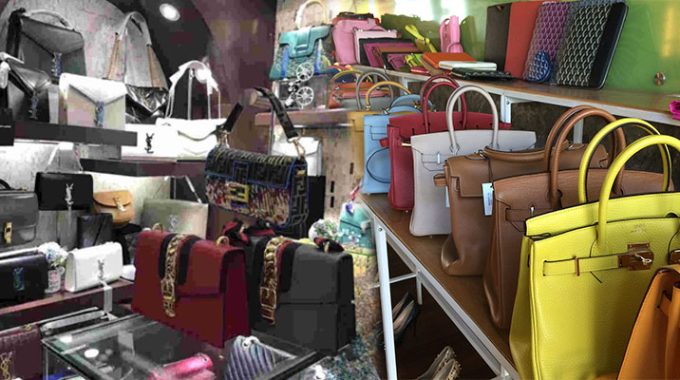Introduction to Branded and First Copy Handbags
Unleash the allure of a luxurious handbag, and heads will turn. There’s something undeniably captivating about carrying a statement piece on your arm, whether it’s an iconic brand name bag or an expertly crafted first copy alternative. But what sets these two options apart? Is there more to consider than just price and label? Join us as we delve into the world of branded versus first copy handbags – exploring quality differences, ethical debates, spotting fakes, and finding alternatives that satisfy both style and conscience. Get ready to unravel the secrets behind designer dreams and discover new avenues for fashion-forward indulgence!
Quality Differences between Branded and First Copy Handbags
When it comes to handbags, quality is an important factor to consider. Branded handbags are known for their superior craftsmanship and attention to detail. These luxury bags are made from high-quality materials that ensure durability and longevity.
On the other hand, first copy handbags often fall short in terms of quality. They are usually made with lower-grade materials that may not withstand daily wear and tear. The stitching on these bags might be uneven or sloppy, leading to potential fraying or unraveling over time.
Branded handbags undergo rigorous quality control measures to ensure every aspect of the bag meets their standards. From the selection of leather to the final stitching, each step is carefully monitored for perfection. This level of precision ensures that branded bags will last for years without losing their shape or falling apart.
In contrast, first copy handbags are mass-produced replicas that aim to imitate the design of branded bags but at a fraction of the cost. While they may look similar on the surface, closer inspection reveals noticeable differences in quality and construction.
It’s important to note that investing in a branded handbag can be seen as a long-term investment due to its higher price tag and superior quality. However, if budget constraints prevent you from purchasing a genuine brand name bag, there are alternative options available – such as buying pre-owned authentic designer pieces or opting for lesser-known brands that offer good quality at affordable prices.
When it comes down to choosing between branded and first copy handbags, understanding the difference in quality is crucial. Quality plays a significant role in determining how long your bag will last and how well it will hold up over time.
Price Differences between Branded and First Copy Handbags
When it comes to purchasing handbags, one of the key factors that influences our decision is the price. And it’s no surprise that there are significant differences in pricing between branded and first copy handbags.
Branded handbags are known for their quality craftsmanship and luxurious materials, which often come with a hefty price tag. These bags are designed by renowned fashion houses and carry their prestigious brand name. The cost of producing these high-quality items reflects in their selling price.
On the other hand, first copy handbags aim to imitate the designs of popular brands at a much lower cost. These replicas may look similar to the original but lack the same level of craftsmanship and material quality. As a result, they are priced significantly lower than authentic branded bags.
The price disparity between branded and first copy handbags can be quite While you may find a designer bag costing hundreds or even thousands of dollars, you can get a replica version for just a fraction of that amount.
However, it’s important to remember that purchasing a first copy bag means supporting counterfeit products and unethical practices. It not only undermines genuine designers’ hard work but also promotes an illegal industry.
Whether you choose to invest in an expensive branded bag or opt for a more affordable replica depends on your personal values, budget constraints, and ethical considerations
The Ethical Debate: Purchasing Branded vs. First Copy Handbags
The Ethical Debate: Purchasing Branded vs. First Copy Handbags
When it comes to buying handbags, the ethical debate between purchasing branded or first copy options is a topic that cannot be ignored. On one hand, purchasing a genuine branded handbag means supporting the craftsmanship and quality of a renowned designer. It also ensures fair wages for workers involved in the production process.
However, some argue that buying first copy handbags is more ethical as it allows individuals with limited budgets to enjoy similar designs at affordable prices. They believe that luxury brands often overprice their products and exclude many consumers from accessing high-quality fashion.
Nevertheless, there are ethical concerns surrounding first copy handbags. These replicas often involve copyright infringement and contribute to the counterfeit industry, which has negative implications on global economies and legitimate businesses.
It’s important to consider both sides of the argument when making your decision. Is it worth sacrificing quality and supporting unethical practices for affordability? Or should you invest in authentic pieces despite the higher price tag?
Each individual must weigh their own values against their budget constraints when deciding whether to purchase branded or first copy handbags. The choice may not always be clear-cut, but understanding the underlying ethical factors can help inform your decision-making process
How to Spot a Fake Brand Name Bag
When it comes to purchasing a brand name bag, there are plenty of sellers out there who try to pass off counterfeit products as the real deal. Spotting these fakes can be challenging, but with a keen eye and some knowledge, you can avoid falling victim to their scams.
Pay close attention to the quality of the bag. Authentic brand name bags are made with high-quality materials that feel luxurious to the touch. Look for any signs of poor craftsmanship or cheap materials such as flimsy hardware or uneven stitching.
Next, examine the logo and branding on the bag carefully. Genuine brand name bags have precise and well-executed logos that are clear and sharp. Counterfeit bags often have blurry or poorly aligned logos due to inferior printing techniques.
Another telltale sign is the price. If a deal seems too good to be true, it probably is! Brand name bags come with a certain price tag for a reason – they are crafted with precision and care using premium materials. So if you stumble upon an incredibly low-priced designer bag online or in-store, proceed with caution.
Additionally, familiarize yourself with authentic product details by researching official websites or visiting authorized retailers. This will help you spot discrepancies in design elements like zippers, lining patterns, or interior labels that may indicate a fake product.
Trust your instincts when making a purchase. If something feels off about the seller’s reputation or their return policy seems sketchy, it’s best to walk away rather than risk buying a counterfeit handbag.
By being vigilant and knowledgeable about what distinguishes an authentic brand name bag from its fake counterpart, you can ensure that your investment is worth every penny while avoiding disappointment down the line
Alternatives to Buying Branded or First Copy Handbags
When it comes to handbags, there are plenty of alternatives to buying branded or first copy options. One option is to explore local and independent designers who offer unique and high-quality bags at a more affordable price point. These designers often put their heart and soul into their creations, resulting in truly one-of-a-kind pieces that you won’t find on everyone’s arm.
Another alternative is to consider vintage or second-hand handbags. Not only can you find beautiful and well-crafted bags from previous eras, but shopping second-hand also helps reduce waste and supports sustainable fashion choices.
If you’re open to trying something different, consider opting for handmade or artisanal bags. These often come with intricate details and craftsmanship that rival the big brands, all while supporting independent artisans around the world.
For those who value sustainability, eco-friendly options made from recycled materials are becoming increasingly popular. Many companies now create stylish handbags using upcycled fabrics or even repurposed materials like old seat belts!
Don’t forget about rental services! If you have an event coming up or simply want to try out a luxury bag without committing to purchasing it outright, renting can be a great option. There are numerous online platforms where you can rent designer bags for a fraction of the retail price.
In conclusion (not conclusive!), there are countless alternatives available if buying branded or first copy handbags isn’t your cup of tea. From supporting local designers to exploring vintage treasures or considering eco-friendly options – the choice is yours! Embrace your individuality and express your style through unique alternatives that align with your values and budget.
Conclusion
When it comes to choosing between branded and first copy handbags, there are several factors to consider. The quality of the bags, the price difference, and the ethical debate surrounding their purchase all play a role in making an informed decision.
If you prioritize top-notch craftsmanship, durability, and authenticity, then investing in a branded handbag is undoubtedly the way to go. These luxury bags not only exude elegance but also offer exceptional quality that can withstand the test of time. However, they come with a hefty price tag that might not be within everyone’s budget.
On the other hand, first copy handbags provide an affordable alternative for those who crave designer styles without breaking the bank. While they may resemble branded bags visually at first glance, these replicas often fall short when it comes to materials used and overall craftsmanship.
The ethical dilemma arises when considering whether purchasing counterfeit goods supports illegal activities such as counterfeiting or intellectual property theft. It is essential to acknowledge that buying fake products undermines brand integrity and contributes to a global industry linked with organized crime.
To avoid falling victim to counterfeit scams while shopping for high-end brands, it’s crucial to know how to spot a fake bag. Familiarize yourself with authentic logos, hardware details, stitching patterns, and even serial numbers if applicable. Online research can help you identify common red flags associated with knockoff items so you can make an informed decision before making your purchase.
However appealing owning a luxury bag may be; alternatives do exist for those seeking style without compromising morals or finances. Second-hand markets offer pre-loved designer pieces at more affordable prices while still maintaining authenticity. Additionally,’ fast fashion’ brands often create trendy designs inspired by popular luxury labels but at significantly lower costs.
In conclusion (without using “in conclusion”), selecting between branded and first copy handbags ultimately boils down to personal preferences and circumstances such as budget constraints or moral values concerning counterfeit products’ purchase.
In today’s fashion world, there is a constant debate between branded and first copy handbags. Both options offer their own unique advantages and disadvantages, making it essential to understand the difference between the two.
Branded handbags are synonymous with luxury, quality, and prestige. They are designed by renowned fashion houses, crafted with superior materials, and undergo strict quality control measures. However, their high price tags may not be accessible to everyone.
On the other hand, first copy handbags provide an affordable alternative for those who desire designer styles without breaking the bank. These replicas often imitate popular brand names’ designs but lack the same level of craftsmanship and material quality as their genuine counterparts.
The ethical dilemma surrounding purchasing branded or first copy handbags cannot be ignored. While buying a genuine branded bag supports fair wages and promotes authentic designers’ hard work, purchasing a fake contributes to illegal activities such as counterfeiting and intellectual property theft.
To make an informed decision when shopping for high-end bags, understanding how to spot a fake is crucial. Paying attention to details such as logo precision, material quality, pricing discrepancies can help distinguish between genuine and counterfeit products.












